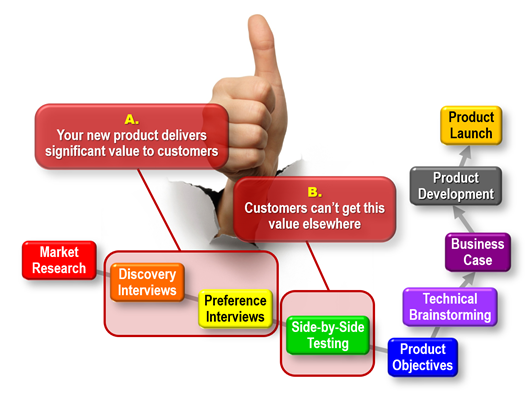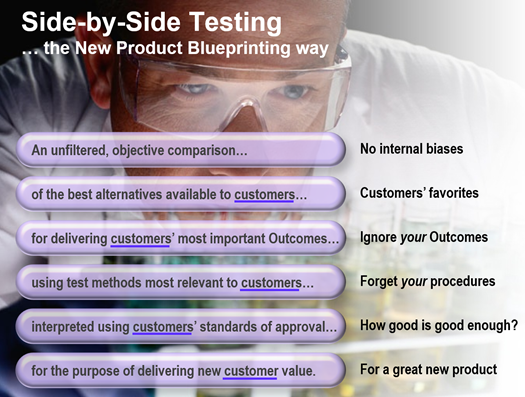You may opt out of Blueprinting Step 4... but first understand its potential benefits.
Many Blueprinting teams complete their interviews, present a Market Case to management, and enter the development stage… without conducting side-by-side testing. And that’s fine, especially if they don’t expect large development costs.
But there are important reasons why your team may want to proceed with this testing. Think of it this way: Your team needs to satisfy two conditions for new product success:
- Your new product must deliver significant value to customers, and…
- Customers can’t get this value elsewhere.
If you just conduct customer interviews, you’ll learn how to meet Condition A… but not Condition B. That requires side-by-side testing.

There are some additional reasons for conducting side-by-side testing:
- Pricing: Your customers will only pay a premium for your new product to the extent it delivers value over the next best alternative. If you don’t quantitatively understand what this alternative provides, you won’t price your new product correctly.
- Strategic design: Instead of being blind to what competing products can do, side-by-side testing shows you their weaknesses… so you can design a product that surpasses them in these areas.
- Customer engagement: Prospects will be more excited about a new product that satisfies the test requirements they’ve explained to you.
- Promotion: When you launch your new product, your side-by-side test data will be useful in showing the advantages of your product vis-à-vis competitors.
Blueprinting side-by-side testing isn’t the same as competitive benchmarking you’ve used or seen elsewhere. The Blueprinting approach is highly customer-centric: As you can see below, it’s “all about the customer.”

Blueprinting side-by-side testing is driven by three questions your Preference interview team asked of customers about each outcome:
- How would you measure if this outcome is satisfied?
- Using this measurement, what test result would be barely acceptable?
- Using this measurement, what test result would make you totally satisfied?
As you’ll see in the following articles, this intelligence lets you replicate the customer experience in your own laboratory. While traditional benchmarking can give you insights into your competitive standing, Blueprinting lets you design a product with confidence. You may still offer customers samples or prototypes, but you’ll know their reaction beforehand. That’s because you designed it using their perspective, not yours.
For more on Blueprinting side-by-side testing, see e-Module 25: Side-by-Side Testing at www.blueprintingcenter.com > e-Learning. Also check out the 2-minute video, Benchmark competing alternatives, part of the B2B Organic Growth video series by Dan Adams.
Keywords: Blueprinting Step 4, side-by-side testing, side by side testing, competitive testing, competitive benchmarking, customer alternative, competitive offering, competing product

